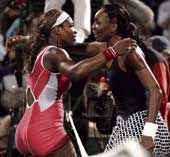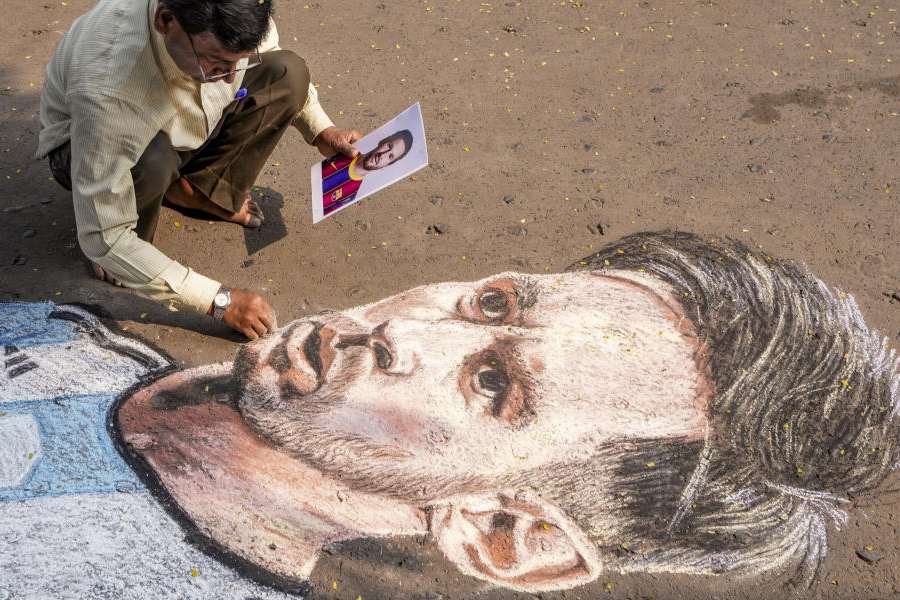 |
| With the arrival of the Williams sisters on the scene, there was a surge in standards |
The Women’s tennis tour, described as being ‘nuts’ in a Harvard business study, seems to be hurtling towards self destruction. The top 20 players read like a casualty list. Their wide range of injuries could add a chapter or two to “Gray’s Anatomy’, the Bible of the medical world.
The lemming like chase for more money orchestrated by a ‘short term perspective’ of ‘extracting maximum gain in minimum time’ has decimated women’s tennis. The Williams sisters, Lindsay Davenport, Maria Sharapova, Justine Henin Hardenne, Jennifer Capriati, Kim Clijsters, Martina Hingis and many others have all been casualties moving in and out of the revolving doors of injury. Sadly, their talent never saw full bloom even though all of them have won Grand Slam titles.
When I first saw the teenaged pigtailed wonders from the US in the mid-fifties, I was overawed and gasped at their skills. They were like lovable clockwork toys. As time moved on and they started to breakdown/burnout, the adulation waned, and there was much indignation at the way the innocence of children was being exploited.
The tennis authorities raised the qualifying age for participation, and imposed restrictions on the number of events youngsters can play in a year in tournaments. However, this did not stop the youngsters from continuing their intensive and punishing training programmes.
With the arrival of the Williams sisters on the scene, there was a surge in women’s standards. The highly ranked women, especially from East Europe, realised that they needed more power, strength and endurance to stay at the top level and challenge the supremacy of the Williams sisters.
This meant more intensive workouts in the gymnasium, with weight training close to masculine levels. Some years ago, the little ‘Swiss Miss’ Hingis, winner of five Grand Slam titles, in a tough match against the broad shouldered muscular Frenchwoman Amelie Mauresmo created a furore by calling her ‘half-man’.
The higher levels of training, combined with almost frantic playing schedules, have made the top women players more vulnerable to injury. Almost 80 per cent of injuries in tennis are due to overuse of limbs.
In fact, they should not be called injuries, as there is no element of chance ? a breakdown is inevitable. The other injuries stem from the technique used in the modern game.
The sideways stance of hitting the ground shots has changed to an open stance. Players now face the net and swivel the hips. Anatomically, our hips are not structured to swivel thousands of times a day. Swivelling puts massive pressure on the back, hips, legs, knees and shoulders, resulting in injuries.
The serve and volley game is extinct. Longer rallies have increased the duration of matches significantly, and put additional strain in legs and endurance. Power in the modern game is generated more by muscle than by swing, resulting ultimately in muscle wear and tear.
Perhaps the most telling impact is of the cruel imbalance created by forcing physical development beyond natural limits, and simultaneously aborting childhood pleasures and forcing immature minds to face the bewildering challenge of fame and money, triggering extreme mental stress and burnout.
The year 2006 has started on an ominous note. The happenings of last week trumpet in no uncertain terms the state of women’s tennis. In a warm-up exhibition tournament in Hong Kong en route to the Australian Open, Serena Williams, winner of seven Grand Slam titles, after a three month layoff, had to withdraw due to a swelling on her knee.
It was not long ago that with her bulging muscles and tree trunk thighs she looked indestructible. Venus Williams was forced off in the match against Sania Mirza for 11 minutes with what was reported as ‘a mystery hip problem’, and flopped in the tournament with a 6-3, 6-1 wipeout by Davenport.
Hingis, now 25 years of age, in her comeback after a three year lay off due to problems with her feet and ankles, strained a hipflexor muscle and lost in the semis in a tournament at Melbourne.
Nadia Petrova, another top notcher, was forced to withdraw due to a thigh injury in the semi-finals of the Auckland Classic. Sharapova is under a cloud, and has withdrawn from a lead-up event to the Australian Open.
In the oven like heat of the Australian Champs, many more will fall. If our Hon’ble Railway Minister Lalu Prasad were in Australia, he would have rushed a relief train to pick up all the casualties.
The saddest part about women’s tennis is the destruction of feminity. Most of the top notchers are six feet and over in height, and with the shoulders of a lumberjack and muscular bodies, they have an intimidating presence. Nature is distorted and pushed beyond limits by exercise regimes and diet supplements. Where, in nature, will you find bulging biceps coupled with ample breasts?
Women players are like genetically modified crops, tailored to perform. What more, one wonders, will they do next. The lure of money and fame is magnetic and irresistible. One can be sure that there is no going back, and this madness will only escalate further.
The halcyon days of ballet like grace, frilly lace dresses delicately enhancing nature’s feminine beauty are a lost fragrance. In the early days, just one fleeting look, a toss of the head and a pout of the lips voiced dissent. Now all this is a distant dream of a lost world.
Alas, women’s tennis is not the only victim of a modern world clamouring for more and more, ruthlessly bulldozing its way through great cultures and hallowed traditions.










